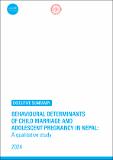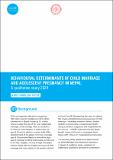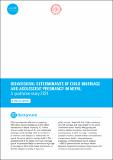Please use this identifier to cite or link to this item:
https://hdl.handle.net/20.500.14356/2356Full metadata record
| DC Field | Value | Language |
|---|---|---|
| dc.contributor.author | NHRC, UNICEF | - |
| dc.date.accessioned | 2024-04-18T06:01:21Z | - |
| dc.date.available | 2024-04-18T06:01:21Z | - |
| dc.date.issued | 2024 | - |
| dc.identifier.citation | Suggested citation: NHRC and UNICEF (2024), Behavioural Determinants of Child Marriage and Adolescent Pregnancy in Nepal: A qualitative study. Kathmandu, Nepal: Nepal Health research council (NHRC) & United Nations Children’s Fund. | en_US |
| dc.identifier.uri | https://hdl.handle.net/20.500.14356/2356 | - |
| dc.description | Research Report. | en_US |
| dc.description.abstract | EXECUTIVE SUMMARY: Even in the face of global achievements, progress toward ending child marriage in Nepal remains inadequate and the rate of decline has been slow. Child marriage has affected 5 million child brides in Nepal, including 1.3 million who are married before the age of 15. Recognizing the pressing need to address this issue, Nepal raised the legal marriage age to 20 for men and women in 2017 and has pledged to end child marriage by 2030. Despite efforts to combat the practice, the prevalence of teenage marriages and pregnancies in Nepal is widespread, especially in marginalized communities. One study identified that child marriage was most prevalent among those who were illiterate, from Dalit communities and indigenous ethnic groups. Women from these communities tended to be uneducated and lacked a basic understanding of reproductive and maternal health, including early marriage increasing the likelihood of early pregnancy and pregnancy-related complications. Nevertheless, the prevalence throughout the country suggests a complex interrelation of caste, ethnicity, regionality and religiosity. It is widely understood that economic factors and family relationships drive early marriage, with detrimental consequences linked to limited mobility and education, compromised health, rising adolescent pregnancy and heightened risk of violence. But what else is at play and at stake? What other behaviors are relevant, and could these be changed to eliminate early marriage? To address these and other questions, UNICEF partnered with the Nepal Health Research Council to develop a study on child marriage and early pregnancy with a focus on marginalized communities in Nepal. | en_US |
| dc.description.sponsorship | United Nations Children’s Fund. | en_US |
| dc.language.iso | en_US | en_US |
| dc.publisher | Nepal Health research council (NHRC) & United Nations Children’s Fund (UNICEF) | en_US |
| dc.subject | Qualitative study | en_US |
| dc.subject | Child Marriage | en_US |
| dc.subject | Adolescent Pregnanc | en_US |
| dc.subject | Nepal | en_US |
| dc.title | Behavioural determinants of child marriage and adolescent pregnancy in Nepal: A qualitative study | en_US |
| dc.title.alternative | A qualitative study | en_US |
| dc.type | Research report | en_US |
| Appears in Collections: | NHRC Research Report | |
Files in This Item:
| File | Description | Size | Format | |
|---|---|---|---|---|
| behavioural-determinants-child-marriage-and-adolescent-pregnancy-nepal.zip | Download Full Report. | 7.97 MB | Unknown | View/Open |
| ECM - Main Report.pdf | Download Full Report. | 6.45 MB | Adobe PDF |  View/Open |
| ECM - Executive Summary.pdf | Executive Summary.pdf | 530.69 kB | Adobe PDF |  View/Open |
| ECM - Method Brief.pdf | Method Brief.pdf | 421 kB | Adobe PDF |  View/Open |
| ECM - Policy Brief.pdf | Policy Brief.pdf | 570.63 kB | Adobe PDF |  View/Open |
Items in DSpace are protected by copyright, with all rights reserved, unless otherwise indicated.
